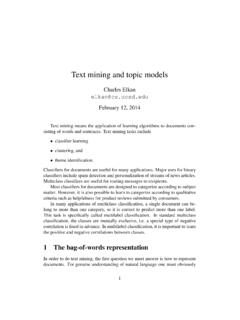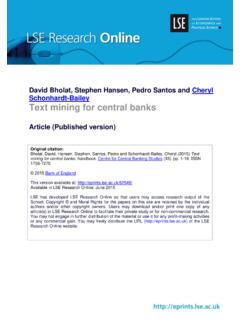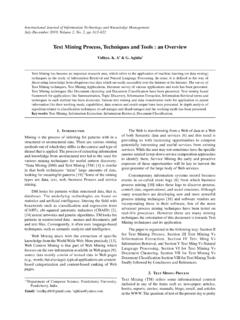Transcription of Text Mining with R { Twitter Data Analysis1
1 Text Mining with R Twitter data Analysis1 . Yanchang Zhao R and data Mining Workshop for the Master of Business Analytics course, Deakin University, Melbourne 28 May 2015. 1. Presented at AusDM 2014 (QUT, Brisbane) in Nov 2014 and at UJAT (Mexico) in Sept 2014. 1 / 34. Outline Introduction Extracting Tweets Text Cleaning Frequent Words and Associations Word Cloud Clustering Topic Modelling Online Resources 2 / 34. Text Mining I unstructured text data I text categorization I text clustering I entity extraction I sentiment analysis I document summarization I .. 3 / 34. 2. Text Mining of Twitter data with R. 1. extract data from Twitter 2. clean extracted data and build a document-term matrix 3. find frequent words and associations 4. create a word cloud to visualize important words 5. text clustering 6. topic modelling 2. Chapter 10: Text Mining , R and data Mining : Examples and Case Studies.
2 4 / 34. Outline Introduction Extracting Tweets Text Cleaning Frequent Words and Associations Word Cloud Clustering Topic Modelling Online Resources 5 / 34. Retrieve Tweets Retrieve recent tweets by @RDataMining ## Option 1: retrieve tweets from Twitter library( Twitter ). tweets <- userTimeline("RDataMining", n = 3200). ## Option 2: download @RDataMining tweets from url <- " ". (url, destfile = "./ "). ## load tweets into R. load(file = "./ "). 6 / 34. ( <- length(tweets)). ## [1] 320. # convert tweets to a data frame <- twListToDF(tweets). dim( ). ## [1] 320 14. for (i in c(1:2, 320)) {. cat(paste0("[", i, "] ")). writeLines(strwrap( $text[i], 60)). }. ## [1] Examples on calling Java code from R ## [2] Simulating Map-Reduce in R for Big data Analysis Using ## Flights data via @rbloggers ## [320] An R Reference Card for data Mining is now available on ## CRAN.
3 It lists many useful R functions and packages for ## data Mining applications. 7 / 34. Outline Introduction Extracting Tweets Text Cleaning Frequent Words and Associations Word Cloud Clustering Topic Modelling Online Resources 8 / 34. library(tm). # build a corpus, and specify the source to be character vectors myCorpus <- Corpus(VectorSource( $text)). # convert to lower case # tm myCorpus <- tm_map(myCorpus, content_transformer(tolower)). # tm # myCorpus <- tm_map(myCorpus, tolower). # remove URLs removeURL <- function(x) gsub("http[^[:space:]]*", "", x). # tm myCorpus <- tm_map(myCorpus, content_transformer(removeURL)). # tm # myCorpus <- tm_map(myCorpus, removeURL). 9 / 34. # remove anything other than English letters or space removeNumPunct <- function(x) gsub("[^[:alpha:][:space:]]*", "", x). myCorpus <- tm_map(myCorpus, content_transformer(removeNumPunct)).
4 # remove punctuation # myCorpus <- tm_map(myCorpus, removePunctuation). # remove numbers # myCorpus <- tm_map(myCorpus, removeNumbers). # add two extra stop words: "available" and "via". myStopwords <- c(stopwords('english'), "available", "via"). # remove "r" and "big" from stopwords myStopwords <- setdiff(myStopwords, c("r", "big")). # remove stopwords from corpus myCorpus <- tm_map(myCorpus, removeWords, myStopwords). # remove extra whitespace myCorpus <- tm_map(myCorpus, stripWhitespace). 10 / 34. # keep a copy of corpus to use later as a dictionary for stem completion myCorpusCopy <- myCorpus # stem words myCorpus <- tm_map(myCorpus, stemDocument). # inspect the first 5 documents (tweets). # inspect(myCorpus[1:5]). # The code below is used for to make text fit for paper width for (i in c(1:2, 320)) {. cat(paste0("[", i, "] ")). writeLines(strwrap( (myCorpus[[i]]), 60)).}
5 }. ## [1] exampl call java code r ## [2] simul mapreduc r big data analysi use flight data rblogger ## [320] r refer card data mine now cran list mani use r function ## packag data mine applic 11 / 34. # tm # myCorpus <- tm_map(myCorpus, stemCompletion). # tm stemCompletion2 <- function(x, dictionary) {. x <- unlist(strsplit( (x), " ")). # Unexpectedly, stemCompletion completes an empty string to # a word in dictionary. Remove empty string to avoid above issue. x <- x[x != ""]. x <- stemCompletion(x, dictionary=dictionary). x <- paste(x, sep="", collapse=" "). PlainTextDocument(stripWhitespace(x)). }. myCorpus <- lapply(myCorpus, stemCompletion2, dictionary=myCorpusCopy). myCorpus <- Corpus(VectorSource(myCorpus)). ## [1] example call java code r ## [2] simulating mapreduce r big data analysis use flights data ## rbloggers ## [320] r reference card data miner now cran list use r function ## package data miner application 3.
6 3. 12 / 34. stemcompletion-is-not-working # count frequency of " Mining ". miningCases <- lapply(myCorpusCopy, function(x) { grep( (x), pattern = "\\< Mining ")} ). sum(unlist(miningCases)). ## [1] 82. # count frequency of "miner". minerCases <- lapply(myCorpusCopy, function(x) {grep( (x), pattern = "\\<miner")} ). sum(unlist(minerCases)). ## [1] 5. # replace "miner" with " Mining ". myCorpus <- tm_map(myCorpus, content_transformer(gsub), pattern = "miner", replacement = " Mining "). 13 / 34. tdm <- TermDocumentMatrix(myCorpus, control = list(wordLengths = c(1, Inf))). tdm ## <<TermDocumentMatrix (terms: 822, documents: 320)>>. ## Non-/sparse entries: 2460/260580. ## Sparsity : 99%. ## Maximal term length: 27. ## Weighting : term frequency (tf). 14 / 34. Outline Introduction Extracting Tweets Text Cleaning Frequent Words and Associations Word Cloud Clustering Topic Modelling Online Resources 15 / 34.
7 Idx <- which(dimnames(tdm)$Terms == "r"). inspect(tdm[idx + (0:5), 101:110]). ## <<TermDocumentMatrix (terms: 6, documents: 10)>>. ## Non-/sparse entries: 4/56. ## Sparsity : 93%. ## Maximal term length: 12. ## Weighting : term frequency (tf). ##. ## Docs ## Terms 101 102 103 104 105 106 107 108 109 110. ## r 0 1 1 0 0 0 0 0 1 1. ## ramachandran 0 0 0 0 0 0 0 0 0 0. ## random 0 0 0 0 0 0 0 0 0 0. ## ranked 0 0 0 0 0 0 0 0 0 0. ## rann 0 0 0 0 0 0 0 0 0 0. ## rapidmining 0 0 0 0 0 0 0 0 0 0. 16 / 34. # inspect frequent words ( <- findFreqTerms(tdm, lowfreq = 15)). ## [1] "analysis" "application" "big". ## [4] "book" "code" "computational". ## [7] " data " "example" "group". ## [10] "introduction" " Mining " "network". ## [13] "package" "position" "r". ## [16] "research" "see" "slides". ## [19] "social" "tutorial" "university". ## [22] "use". <- rowSums( (tdm)).
8 <- subset( , >= 15). df <- (term = names( ), freq = ). 17 / 34. library(ggplot2). ggplot(df, aes(x = term, y = freq)) + geom_bar(stat = "identity") +. xlab("Terms") + ylab("Count") + coord_flip(). use university tutorial social slides see research r position Terms package network Mining introduction group example data computational code book big application analysis 0 50 100 150. Count 18 / 34. # which words are associated with 'r'? findAssocs(tdm, "r", ). ## r ## example ## code # which words are associated with ' Mining '? findAssocs(tdm, " Mining ", ). ## Mining ## data ## mahout ## recommendation ## sets ## supports ## frequent ## itemset 19 / 34. library(graph). library(Rgraphviz). plot(tdm, term = , corThreshold = , weighting = T). use r group university computational package example tutorial social research Mining see code network position data book analysis big application introduction slides 20 / 34.
9 Outline Introduction Extracting Tweets Text Cleaning Frequent Words and Associations Word Cloud Clustering Topic Modelling Online Resources 21 / 34. m <- (tdm). # calculate the frequency of words and sort it by frequency <- sort(rowSums(m), decreasing = T). # colors pal <- (9, "BuGn"). pal <- pal[-(1:4)]. # plot word cloud library(wordcloud). wordcloud(words = names( ), freq = , = 3, = F, colors = pal). 22 / 34. dynamic snowfall opportunity contain search itemset performance distributed charts san knowledge frequent sydney canberra canada visit studies elsevier cloud initial experience visualisations thanks industrial hadoop answers outlier technique start text added quick package work plot ibm new week present due pdf analytics document forecasting tried format modeling introduction fellow youtubegoogle time nd job computational university interacting web mid software amp book tutorial application machine access view rdatamining notes chapter data can project statistical tj reference southern scientist graphmay sentiment case now talk see fast create csiro simple published postdoc edited postdoctoral r large group watson slides Mining list short engineer online technological china high free th cfp recent research vacancies us guidance open user tool
10 April example video linkedin topic australia conference handling find build series jan graphical parallel get detection analysis big igraph code use rstudio social top business postdocresearch titled associate follow website process network media detailed map rule ausdm card area dmapps call learn melbourne program california senior position language database science lecture coursealso event prediction centerlab cluster spatial easier analyst poll check function join twitterpage submission dataset draft singapore state kdnuggets provided advanced comment classification dec cran informatics management wwwrdataminingcom tweet track microsoft 23 / 34. Outline Introduction Extracting Tweets Text Cleaning Frequent Words and Associations Word Cloud Clustering Topic Modelling Online Resources 24 / 34. # remove sparse terms tdm2 <- removeSparseTerms(tdm, sparse = ).









